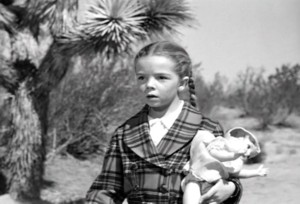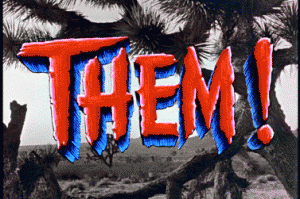 “ . . . and the beasts shall reign over the earth.”
“ . . . and the beasts shall reign over the earth.”
Them! is a neat film.
It was born out of the nuclear fears—the Cold War—of the 1950s, and is perhaps the best of similar films of that decade about insects, arachnids, cephalopods, whatever, grown large and sassy on overdoses of radiation—It Came from Beneath the Sea, Tarantula, The Black Scorpion and The Beast from 20,000 Fathoms, to name a few. The Naked Jungle may seem to apply here, as it does concern army ants amuck in the jungles of South America, but, though numerous and organized, they’re still their normal size. In Them!, the mutating radiation comes, supposedly, from A-bomb explosions in the New Mexico desert in 1945.
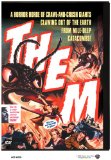 Made in 1954, the film has some distinctive credentials. Its director, Gordon Douglas, although not a first-stringer, directed Up Periscope (1959), The Charge at Feather River (1953) and probably his best-remembered film, Robin and the 7 Hoods (1964). Cinematographer Sid Hickox’s work is somewhat more impressive: A Bill of Divorcement (1932), Katharine Hepburn’s first film, The Big Sleep (1946), White Heat (1949) and five Errol Flynn flicks in the ’40s, none of them distinguished by the star’s acting. Them! was Hickox’s next-to-last film before he entered television, photographing, for example, 237 episodes of The Andy Griffith Show, among many other productions.
Made in 1954, the film has some distinctive credentials. Its director, Gordon Douglas, although not a first-stringer, directed Up Periscope (1959), The Charge at Feather River (1953) and probably his best-remembered film, Robin and the 7 Hoods (1964). Cinematographer Sid Hickox’s work is somewhat more impressive: A Bill of Divorcement (1932), Katharine Hepburn’s first film, The Big Sleep (1946), White Heat (1949) and five Errol Flynn flicks in the ’40s, none of them distinguished by the star’s acting. Them! was Hickox’s next-to-last film before he entered television, photographing, for example, 237 episodes of The Andy Griffith Show, among many other productions.
 James Whitmore has top billing. Still active at 87, never a leading man and early on growing into a grizzled, tough, bone-legged codger, his first film was Battleground (1949), earning a best supporting actor nomination. The Next Voice You Hear the following year is about a man’s reaction to hearing God’s voice on the radio, and that same year he played a bookie in John Huston’s The Asphalt Jungle. He was nominated best actor for Give ‘em Hell, Harry! in 1975. The prison librarian, Brooks Hatlen, in The Shawshank Redemption (1994), is his most important recent movie role. Since the mid-‘50s, he has worked more in television than in films, appearing recently in an episode of CSI: Crime Scene Investigation.
James Whitmore has top billing. Still active at 87, never a leading man and early on growing into a grizzled, tough, bone-legged codger, his first film was Battleground (1949), earning a best supporting actor nomination. The Next Voice You Hear the following year is about a man’s reaction to hearing God’s voice on the radio, and that same year he played a bookie in John Huston’s The Asphalt Jungle. He was nominated best actor for Give ‘em Hell, Harry! in 1975. The prison librarian, Brooks Hatlen, in The Shawshank Redemption (1994), is his most important recent movie role. Since the mid-‘50s, he has worked more in television than in films, appearing recently in an episode of CSI: Crime Scene Investigation.
Them! begins in the New Mexico desert as a biplane and a patrol car from the state police search for a little girl (Sandy Descher) and find her in obvious shock. One of the best moments in the film comes early. While lying in an ambulance, a peculiar, vibrating sound prompts her to sit up, transfixed, staring blankly into space. The sound ceases and she lies back down, unnoticed by the two men attending her—Whitmore, one of two state officers, and the only appearance of ambulance driver William Schallert, an actor better known for his larger role as the sly mayor in In the Heat of the Night (1967).
More disturbing things occur. Grant Johnson’s general store and a trailer are wrecked, as if by a strong force from the inside, as James Whitmore observes, but once the viewer knows the cause, wouldn’t it be just the opposite?! Johnson is killed, but in both places no money is taken. Strangely, though, sugar containers have been ransacked. Hum-m-m—— The store owner has “enough formic acid in him to kill twenty men.” (Even a first-time viewer should begin to get the idea!) James Whitmore’s partner meets a similar fate. Photographed from the other side of a window, he and his killer are unseen. In the best cinematic tradition of showing little or nothing for the greatest effect, contrary to the current vogue, only the officer’s futile gunshots and screams are heard—and that vibrating noise!
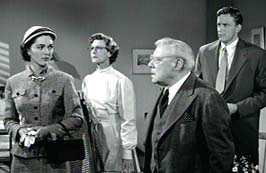 James Arness—of Gunsmoke fame—arrives from the F.B.I. It’s all beyond his understanding, including the peculiar depression found in the desert sand. Why, under the circumstances, only one print? Naturally, an “authority” is summoned, since these kinds of films require a voice for what’s amiss—and also to explain to the audience, as is done here, the exact nature of things and, inevitably, how human kind hangs in the balance. The authority proves to be a 77-year-old actor, Edmund Gwenn, who clearly steals the show. He won the supporting actor Oscar in 1947 for Miracle on 34th Street as the benevolent old Saint Nicholas, and, in 1954, was one year away from his droll role in Alfred Hitchcock’s The Trouble with Harry.
James Arness—of Gunsmoke fame—arrives from the F.B.I. It’s all beyond his understanding, including the peculiar depression found in the desert sand. Why, under the circumstances, only one print? Naturally, an “authority” is summoned, since these kinds of films require a voice for what’s amiss—and also to explain to the audience, as is done here, the exact nature of things and, inevitably, how human kind hangs in the balance. The authority proves to be a 77-year-old actor, Edmund Gwenn, who clearly steals the show. He won the supporting actor Oscar in 1947 for Miracle on 34th Street as the benevolent old Saint Nicholas, and, in 1954, was one year away from his droll role in Alfred Hitchcock’s The Trouble with Harry.
He plays one of the two doctor Medfords, Harold, a brilliant myrmecologist. Yes, as James Arness says, “A what?! Why not speak English?” Which is what he suggests to the second doctor Medford, Patricia, the daughter, played by Joan Weldon, who provides the potential love interest—not developed—for Arness. Though lovely of face, she is rather bland, both as an actress and as the source of James Arness’ quick interest. Perhaps it has something to do with her ’50s style clothes, which clearly date the film and recall what Betty Ferness wore when pushing refrigerators on TV at the time.
Well, back to the story—- The little girl, now in a hospital, is given a sniff of formic acid by the senior Medford, which awakens her from her traumatized state, screaming, “Them! Them!”
After returning to the desert, the quartet of leading players encounters the first sight of what the astute movie-goer has already suspected. A gigantic ant. But this revelation has been twenty-eight minutes in coming, the suspense and expectation finely held, something, however, that wouldn’t be permitted today; contemporary audiences want an immediate adrenalin rush, as in the latest James Bond adventure, Quantum of Solace.
“Shoot for the antennae!” shouts Medford. Which James Whitmore does with his revolver, before grabbing a machine gun from his patrol car and finishing off the eight-foot monster. Medford has the opportunity, forthwith, to suggest the possible fulfillment of a Biblical prophecy, something about—oh, yes: “ . . . and the beasts shall reign over the earth.”
The film temporarily loses some of its suspense, now that everyone knows what’s what, and becomes more routine, in the tradition of monster and alien invasions: the good scientist briefs those in power about what’s to be done (Edmund Gwenn is totally convincing), the police and U.S. Army mobilize, the enemy proves resourceful, even attacking a ship at sea and breaking into a train car of sugar, marshal law is declared in a dramatic radio/TV broadcast, the invaders are ultimately cornered in a final battle and one of the leading characters, as is usually required, dies (Whitmore in this case), crushed in the pincers of an ant. Oh-h-h-h—- that must hurt!
Before the final battle, the suspense, however, is rejuvenated when the ants are discovered hiding in the storm sewers of Los Angeles. A father, killed by the ants, had taken his two boys to play with their airplane in a dried up river bed near the sewer entrances. Jerry and Mike have unwittingly escaped into the sewers, which adds poignancy to the proceedings. In goes the military! The boys are saved.
 Them! is not without its humor, especially when James Arness and Weldon interrogate three drunks and a ranch foreman who crashed his plane when he was attacked by strange objects. The Texas pilot, Fess Parker, uncredited, effectively steals the scene, walking back and forth in his pajamas and bathrobe. “All of a sudden I seen these, these flying saucers—three of ‘em, one big one and two little ones. . . . They were shaped like—well, like ants.” It was this lone appearance in the film that prompted Walt Disney to select Fess Parker as the frontiersman Davy Crockett in a super hit the next year.
Them! is not without its humor, especially when James Arness and Weldon interrogate three drunks and a ranch foreman who crashed his plane when he was attacked by strange objects. The Texas pilot, Fess Parker, uncredited, effectively steals the scene, walking back and forth in his pajamas and bathrobe. “All of a sudden I seen these, these flying saucers—three of ‘em, one big one and two little ones. . . . They were shaped like—well, like ants.” It was this lone appearance in the film that prompted Walt Disney to select Fess Parker as the frontiersman Davy Crockett in a super hit the next year.
Also walking across a room, having pulled from the telex machine a wire about the pilot’s encounter, Leonard Nimoy discusses with a clerk the Texas proclivity for exaggeration. His two minutes on screen, much of it consumed by an insert of the wire, will be vindicated twelve years later with sudden fame as Mr. Spock in Star Trek.
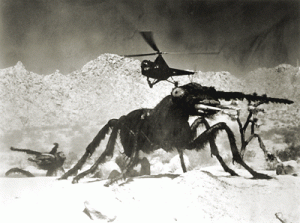 Although Them! has more than its share of goofs, from scientific inaccuracies to studio cars being caught on camera, the storm sewer sequence is a reason, perhaps, for the film’s nomination for its special effects. The main reason, of course, is the giant ants, astonishing in their day. Well, maybe “astonishing” is too strong a word! To sophisticated viewers used to computer-generated tricks of the 21st century, the ants seem unconvincing bobble head dolls, with legs that dangle above ground rather than dig in and simulate propulsion. This specific Oscar went to 20,000 Leagues Under the Sea for another giant creature, a squid, though large naturally, without a dose of radiation.
Although Them! has more than its share of goofs, from scientific inaccuracies to studio cars being caught on camera, the storm sewer sequence is a reason, perhaps, for the film’s nomination for its special effects. The main reason, of course, is the giant ants, astonishing in their day. Well, maybe “astonishing” is too strong a word! To sophisticated viewers used to computer-generated tricks of the 21st century, the ants seem unconvincing bobble head dolls, with legs that dangle above ground rather than dig in and simulate propulsion. This specific Oscar went to 20,000 Leagues Under the Sea for another giant creature, a squid, though large naturally, without a dose of radiation.
Them! suggests an occasional slipshod approach that began, really, before it was made. It was planned for color, but at literally the last minute the cost-conscious Warner Bros. decided on black and white. A spot of color does exist in the title card, in three-dimensional red letters, against an otherwise black and white landscape of Joshua trees and the desert.
And, per the genre requirements, the film closes ominously, implying that these ninety-four minutes or so might not be the end of the ants. After the last nest has been torched, Edmund Gwenn, still convincing—and thoroughly involved—in his role, has the final words: “When man entered the atomic age, he opened a door into a new world. What he’ll eventually find in that new world no one can predict.”
No, not all that profound but appropriate for a film that’s a bit of a gem.
